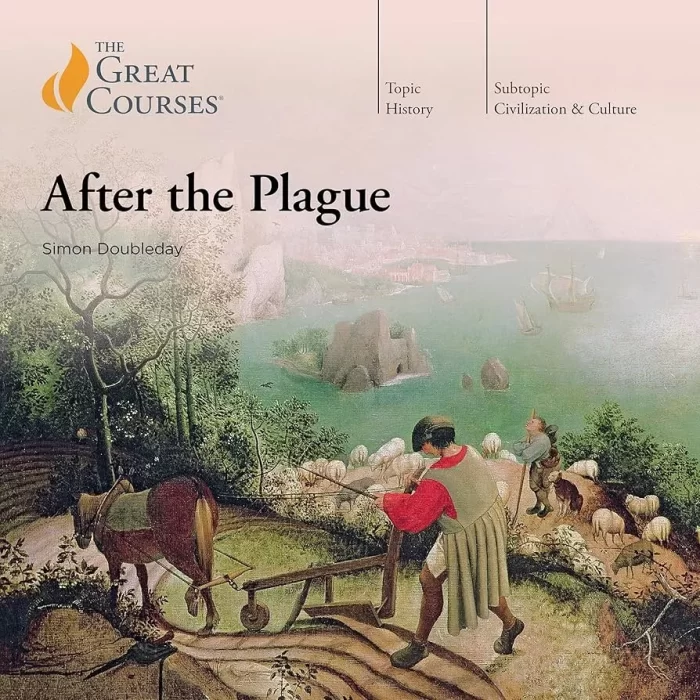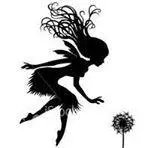Please scroll down for an English review.
קורס נוסף מבית Great Corses, והפעם קורס בנושא השפעות המתמשכות והעמוקות של המגיפה השחורה בתחומי התרבות והחברה.
המוות השחור, שהגיע לאירופה בשנת 1347, היה אחד מאסונות הטבע הקטלניים ביותר שידעה האנושות. מחקרים חדשים מצביעים שהמגיפה החלה להתפשט ממרכז אסיה ובאמצע המאה ה-14 התפרצה באירופה. השפעותיה היו הרסניות ומעריכים ששיעורי התמותה היו גבוהים משליש מהאוכלוסייה. ההערכה הרווחת כיום היא שהמגיפה הרגה בין 40 ל- 50 אחוז מהאוכלוסייה.
מחקרים גם מצביעים שהמגיפה תקפה בגלים אבל בני התקופה לא נכנעו לה. מי ששרד את הגל הראשון, ואלה שנולדו בעשורים שלאחריו, הסתגלו אל הטראומה וניסו לבנות את עולמם מחדש.
המוות השחור השפיע על כל תחומי החיים. הוא בא לידי ביטוי בספרות, באמנות, הכלכלה, חיי הרוח והחל את החיפוש אחר צדק חברתי.
המרצה, מדגים מכתביו של ג'פרי צ'וסר, הסופר בן התקופה. כאשר המגיפה פרצה צ'וסר היה בן שש. עם השנים הוא הצליח לפלס את דרכו חברתית אל מעמד האצולה ובית המלוכה. יצירותיו של צ'וסר ובעיקר "סיפורי קנטרברי" הם קפסולת זמן שבה הוא תיעד את התקופה. היצירות מאפשרות לקורא בן זממנו לקבל תובנות על החיים בתקופה.
דאבלדיי חוקר את השינויים החברתיים והתרבותיים מארבע זויות שונות תוך שהוא מתבסס על מקורות תקופתיים כגון "סיפורי קנטרברי" של צ'וסר, "דקאמרון" של בוקאצ'יו ותיאורים תקופתיים אחרים :
- שינויים חברתיים: עליית מעמד הביניים, שינויים ביחסי כוח בין אדונים לאיכרים.
- התפתחויות כלכליות: שינויים בשוק העבודה, עליית שכר, שינויים בבעלות על קרקעות.
- השפעות תרבותיות: שינויים באמנות, בספרות ובדת.
- התפתחות הרפואה: התקדמות בהבנת מחלות ובשיטות טיפול.
למרות שהספר בעיקרו אקדמי, הפרקים מעניינים, קולחים ומרתקים.
המגפה השחורה, למרות שהיתה אירוע קטסטרופלי ומפחיד, עוררה שינויים מהותיים בתחומי היצירתיות, המחשבה הדתית והחברה. היא השפיעה במיוחד על מעמד הנשים. יש לזכור שמיזוגניה וסקסיזם מודחקים, עולים וצפים לפני השטח והם מחריפים בתקופות של משבר חברתי.
שאלות על עצמאות האישה, האוטונומיה והמיניות שלה ריחפו באוויר.
אנשים רבים במאה ה-14 היו ממש אובססיביים לשאלות אוטונומיה והמיניות של נשים. למרות שהיו נשים חזקות ומשפיעות עוד לפני המגיפה, תקופת המגיפה השחורה, איפשרה קריאת תגר על המבנים החברתיים המקובלים.
הסופרת, בת המאה ה 15, כריסטין דה פיסאן עודדה נשים להיות צייתניות לבעליהן, אך בו זמנית היא טענה שאם נשים היו חלשות יותר או פחות מוכשרות מגברים, זו תוצאה של חינוך והכשרה. ההיסטוריונית קרוליין בארון טוענת שבמהלך ימי הביניים המאוחרים, לנשים הייתה מידה משמעותית של כוח כלכלי ועצמאות: לנהל עסקים משלהן, לשלם את המסים שלהן ולהכשיר את עצמן. הן היו פעילות בסוגי מסחר שונים והאריכו חיים בשל תזונה טובה יותר.
יחד עם זאת, יש לזכור שחיי הנשים מהמעמד הנמוך המשיכו להיות קשים ושלעיתים אובדן הבעל הוביל ללחצים כלכליים משמעותיים.
דאבלדיי מקדיש פרק ליהודים בתקופת המגיפה השחורה. למרות האלימות והרדיפות שהקהילה היהודית ספגה, הסיפור של היהודים במאה ה -14 כולל מספר מקרים בולטים של חוסן ואף התנגדות. לאורך המאה ה 14, הקהילות היהודיות שרדו בכל רחבי אירופה. יחד עם זאת יש לראות בתקופה סימני אזהרה.
מלך אנגליה גירש את היהודים כבר ב 1290. היהודים לא ישובו לאנגליה עד המאה ה – 17. צרפת ביצעה שני גירושים הראשון ב- 1306 והשני ב – 1322. רבים יצאו לגלות באיזורי הריין או הרי הפירנאים וקטלוניה.
הקהילות היהודיות בדרום צרפת התמודדו עם התקפות אלימות של חמושים נוצרים. בערים שונות בספרד הם גם התמודדו עם התקפות אלימות. כך גם בשוויץ ובגרמניה. לא מדובר בהתפרצויות אלימות אקראיות וספורדיות אלא באלימות שיטתית שנועדה להשמיד את היהודים.
הטרגדיות שפקדו את קהילות יהודי צפון אירופה לא היו אחידות. יהודים רבים היגרו מגרמניה ומצרפת לאיטליה.
אפילו היהודים בספרד הפגינו כושר התאוששות והניצולים מהטבח ומהפרעות חזרו לקהילות היהודיות.
נהנתי מההרצאות ומהידע המעמיק שמפגין המרצה. ההרצאות נמסרות באופן קולח ובקול נעים, הידע שהוא מעביר מרתק והוא מצליח להעניק תמונה של 360 מעלות על החיים בימי הביניים בתקופת המגיפה.
After The Plague/ Simon Doubleday
Kindle Edition, 216 pages, 2022
דירוג SIVI –
איכות אודיו –

Another course from Great Courses, this time on the lasting and profound effects of the Black Plague on culture and society.
The Black Death, which struck Europe in 1347, was a catastrophic event of unprecedented scale. New studies suggest that it originated in Central Asia and spread to Europe in the mid-14th century. Its effects were devastating, with death rates estimated to have claimed the lives of over a third of the population. However, the true extent of the tragedy remains uncertain, with some estimates suggesting that the epidemic may have killed as much as 50 percent of the population.
Studies also indicate that the epidemic came in waves, but the people of the time did not succumb to it. Those who survived the first wave and those born in the following decades showed remarkable resilience in adapting to the trauma and rebuilding their world.
The Black Death affected all realms of life. It was expressed in literature, art, economics, and spiritual life and began the search for social justice.
The lecturer presents the writings of Geoffrey Chaucer, a writer of his time who was six years old when the plague broke out. Over the years, he climbed socially to the status of the aristocracy and the royal house. Chaucer's works, particularly "The Canterbury Tales," are more than just literary works. They are a precious time capsule that he used to record the period, offering contemporary readers a unique opportunity to understand life in that era.
Doubleday investigates the social and cultural changes from four different angles while basing himself on period sources such as "The Canterbury Tales" by Chaucer, "The Decameron" by Boccaccio, and other period descriptions:
Social changes, such as the rise of the middle class and significant shifts in power relations between lords and peasants, are key aspects that shed light on the historical shifts in power dynamics.
Economic developments: changes in the labor market, wage increases, changes in land ownership.
Cultural influences: The Black Plague brought about significant changes in art, literature, and religion, enriching the cultural landscape of the time.
The development of medicine: progress in understanding diseases and treatment methods.
Although the book is mainly academic, the chapters are interesting, fluid, and fascinating.
The Black Plague, a catastrophic and frightening event, provoked fundamental changes in the fields of creativity, religious thought, and society. Its influence on the status of women is also significant. It's crucial to understand that in times of social crisis, such as the Black Plague, issues like misogyny and sexism, which are usually repressed, tend to rise to the surface and worsen.
Questions about women's independence, autonomy, and sexuality hung in the air.
Many people in the 14th century were obsessed with questions of women's autonomy and sexuality. Although there were robust and influential women even before the epidemic, it was possible to challenge the accepted social structures during the Black Epidemic.
The 15th-century writer Christine de Pisan encouraged women to be obedient to their husbands. Still, she also argued that if women were weaker or less talented than men, it was not due to inherent inferiority, but a result of their lack of education and training. Historian Caroline Barron argues that during the late Middle Ages, women had a significant degree of economic power and independence: they could run their own businesses, pay their own taxes, and educate themselves. They were active in various types of trade and extended their lives due to better nutrition.
At the same time, it must be remembered that the lives of women from the lower class continued to be difficult and that sometimes, the loss of a husband led to significant financial pressures.
Doubleday dedicates a chapter to Jews during the Black Plague. Despite the violence and persecution that the Jewish community suffered, the story of the Jews in the 14th century is one of survival and even resistance. Throughout the 14th century, Jewish communities not only endured but also managed to thrive all over Europe. At the same time, warning signs should be seen during this period.
The King of England expelled the Jews as early as 1290. The Jews did not return to England until the 17th century. France carried out two deportations, the first in 1306 and the second in 1322. Many went into exile in the Rhine, the Pyrenees, and Catalonia.
The Jewish communities in the south of France faced violent attacks by Christian militants. In various cities in Spain, they also faced violent attacks. The same is true in Switzerland and Germany. These are not random and sporadic outbreaks of violence but systematic violence designed to destroy the Jews.
The tragedies that befell the Jewish communities of Northern Europe were not uniform. Many Jews immigrated from Germany and France to Italy. Even the Jews in Spain showed resilience, and the survivors of the massacre and disturbances returned to the Jewish communities.
I enjoyed the lectures and the in-depth knowledge demonstrated by the lecturer. The lectures were delivered fluently and in a pleasant voice. His knowledge is fascinating, and he gave a 360-degree picture of life in the Middle Ages during the epidemic.
לגלות עוד מהאתר Sivi's Books
Subscribe to get the latest posts sent to your email.

